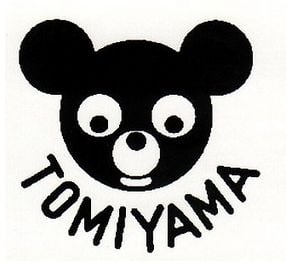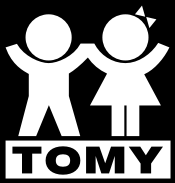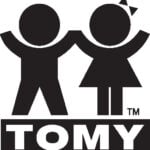
Tomy is one of the most influential toy companies in Japan, with a legacy spanning over a century. Its history is marked by innovation, global expansion, and a commitment to creativity and quality in children’s entertainment. The Tomy logo has undergone a few changes over the years, and they reflect the growth, technological advancements, and the commitment of the company to innovation and playfulness. The article delves into the evolution of the Tomy logo over the years.
The Genesis of the Tomy Logo (1924–1963)
Tomy was founded in 1924 as Tomiyama Toy Seisakusho by Eiichirō Tomiyama in Japan. The original logo featured the combination of an emblem and the wordmark arched below. The emblem in black and white resembled the visage of a playful bear with rounded ears. The brand name “Tomiyama” in black uppercase and in a sans-serif typeface was arched below the emblem to give the vibe of a toy company and remain attractive to children.

(1963 – 1981)
The next logo iteration of 1963 featured the playful imagery of a boy and girl in white holding hands against a bigger black rectangular background. Below them was written the brand name “Tomy” in black, bold, uppercase against a smaller white rectangular background. In an alternative variant, the colours of the logo were reversed.


(1981 – 2000)
The next logo iteration came about in 1981 and featured the word “TOMY” in bold, rounded uppercase black and red letters (separately) set against a white background. This simple yet striking design was versatile and appeared in various forms across different media, including video games and product packaging.


(2000 – 2006) (Japan/Asia); (2006 – 2014) (Japan, Secondary); (2000 – Present) (International)
The present Tomy logo features the bold brand name in blue, where one side of each individual letter is thicker and wider. Also, one side of the horizontal bar in “T” was cut at an angle to enhance style and visual acuity.

The Elements of the Tomy Logo
Font
The wordmark in the Tomy logo is written using a bold and rounded sans-serif font that conveys a friendly and approachable image. The font style is simple yet distinctive and is designed to be easily readable and appealing to children and families.
Colour
The colour scheme used in the Tomy logo is blue to symbolise trust and reliability while maintaining a lively appearance.
The History of Tomy
Tomy was founded in 1924 by Eiichirō Tomiyama as Tomiyama Toy Seisakusho (Tomiyama Toy Manufacturing Company). Initially, the company specialised in producing elaborate tin toy aeroplanes, which earned it the nickname “Aero Plane TOMIYAMA”. By 1929, Tomiyama played a key role in organising the Japanese toy makers association, which helped improve toy quality and design and established Japan as a major centre for toy manufacturing.
In 1935, Tomiyama established a research and development centre, a forward-thinking move that set the company apart in innovation and technical advancement. However, the Second World War interrupted toy production as resources were redirected to the war effort.
After the war, Tomy resumed toy production, and, in 1953, it was formally incorporated as Tomy Company Ltd. The company quickly adapted to new materials and pioneered the use of plastics in toys, which allowed for greater creativity and complexity in design. Early successes included friction-powered models of the B-29 and B-50 bombers, which became popular both in Japan and overseas. These helped establish Japan’s reputation in the global toy industry.
In 1957, Tomy launched a mechanical elephant that could blow soap bubbles. It combined cuteness with mechanical ingenuity – a hallmark of Japanese toy design. The toy was a massive success and sold over 600,000 units. Tomy’s international expansion began in the 1970s. In that year, the company opened its first overseas manufacturing facility in Hong Kong, which was followed by the establishment of a U.S. sales subsidiary in 1973. The company entered the European market in 1982 with a UK subsidiary and then expanded to France and Belgium in 1985.
A defining product line from this era was Tomica, a series of die-cast miniature cars launched in 1970. Initially it featured only Japanese models and then quickly expanded to include international vehicles and became a global hit, especially in Europe. By the late 1970s, the product line included over 180 models and inspired the creation of Tomica World, a range of accessories and playsets. Tomy also invested in accessible toy design and established the Accessible Design Toy Laboratory in the 1980s to create toys for children with disabilities.
During the 1990s, Tomy continued to innovate and expand its product offerings. The company opened manufacturing and engineering plants in China and the U.S., and in 1999, it went public on the Tokyo Stock Exchange. Tomy also formed a significant partnership with Hasbro to enhance its global reach. Tomy secured exclusive licenses for major brands, including Disney characters in Japan, Teletubbies, Star Wars, and Thomas the Tank Engine in the UK. The company also produced toys for the Pokémon franchise, which further cemented its status as a leading toy manufacturer.
In 2006, Tomy merged with another major Japanese toy company, Takara, to form Takara Tomy (TOMY Company, Ltd.). The merger was aimed at leveraging their combined strengths in product development and marketing. The merged entity sought to become the world’s top toy manufacturer and expanded aggressively into global markets. Tomy introduced popular brands like Tomica and Beyblade to international audiences. In 2011, it acquired U.S. toy manufacturer RC2 (now TOMY International) to establish a solid platform for global development.
Tomy has embraced digital transformation by fusing analogue and digital technology to create innovative toys that meet contemporary needs. The company has focused on “product branding” and “toys 4.0” by blending traditional play with cutting-edge technology. In 2024, Tomy celebrated its 100th anniversary to mark a century of creativity, innovation, and global influence in the toy industry. Today, Tomy is recognised for its enduring brands, international presence, and commitment to quality and play.
Interesting Facts About Tomy
- Tomy Company, Ltd. is one of Japan’s oldest and most influential toy manufacturers. It was originally founded in 1924 by Eiichirō Tomiyama as the Tomiyama Toy Manufacturing Company.
- The company was officially incorporated as Tomy Company in 1953 and is now known as Takara Tomy in Asia after merging with Takara in 2006.
- Tomy’s name is an abbreviation of its founder’s surname, Tomiyama.
- Tomy is Japan’s second-largest toy manufacturer and ranks among the top five toy companies worldwide.
- The company is known for its innovation and is among the first to develop toys using new technologies like transistors and microchips.
- Tomy pioneered several toy trends, such as handheld electronic games and robot toys, and released some of the earliest talking dolls and electromotive train sets in the 1960s.
- Tomy is famous for the Tomica series of miniature cars, which have become collectibles globally.
- The company holds exclusive licenses for producing Disney character toys in Japan. It has also produced toys for franchises like Star Wars, Teletubbies, and Thomas the Tank Engine.
- Tomy was the first to commercialise Pokémon toys. It secured the rights before the franchise became a global phenomenon. Its “Monster Collection” figures were a major hit and doubled the company’s sales.
- Other popular Tomy products include the Pop-up Pirate game, Waterfall games, and the Micropets series.
- Tomy has subsidiaries and distribution partnerships worldwide, which include the United States, the United Kingdom, France, Hong Kong, and Thailand.
- The company is publicly traded on the Tokyo Stock Exchange and remains partially owned by the Tomiyama family.
- One of Tomy’s earliest hits was an elephant toy that blew soap bubbles. It sold more than 600,000 units in the late 1950s.
- Tomy once produced a model of the B-29 bomber, which became a lucrative export and helped establish Japan’s reputation in the global toy industry.
- The company’s commitment to research and development has been a hallmark since the 1930s. It had a dedicated R&D team that grew to over 200 people worldwide.
Finally
The Tomy logo and its various iterations over the years show how the company has evolved from being a local Japanese toy maker to a global leader in play and entertainment. Each iteration of the logo has captured the spirit of its era using bold simplicity, digital animation, or symbolic celebration. The Tomy logo has stayed true to the mission of the company of inspiring and delighting generations of children and families worldwide.